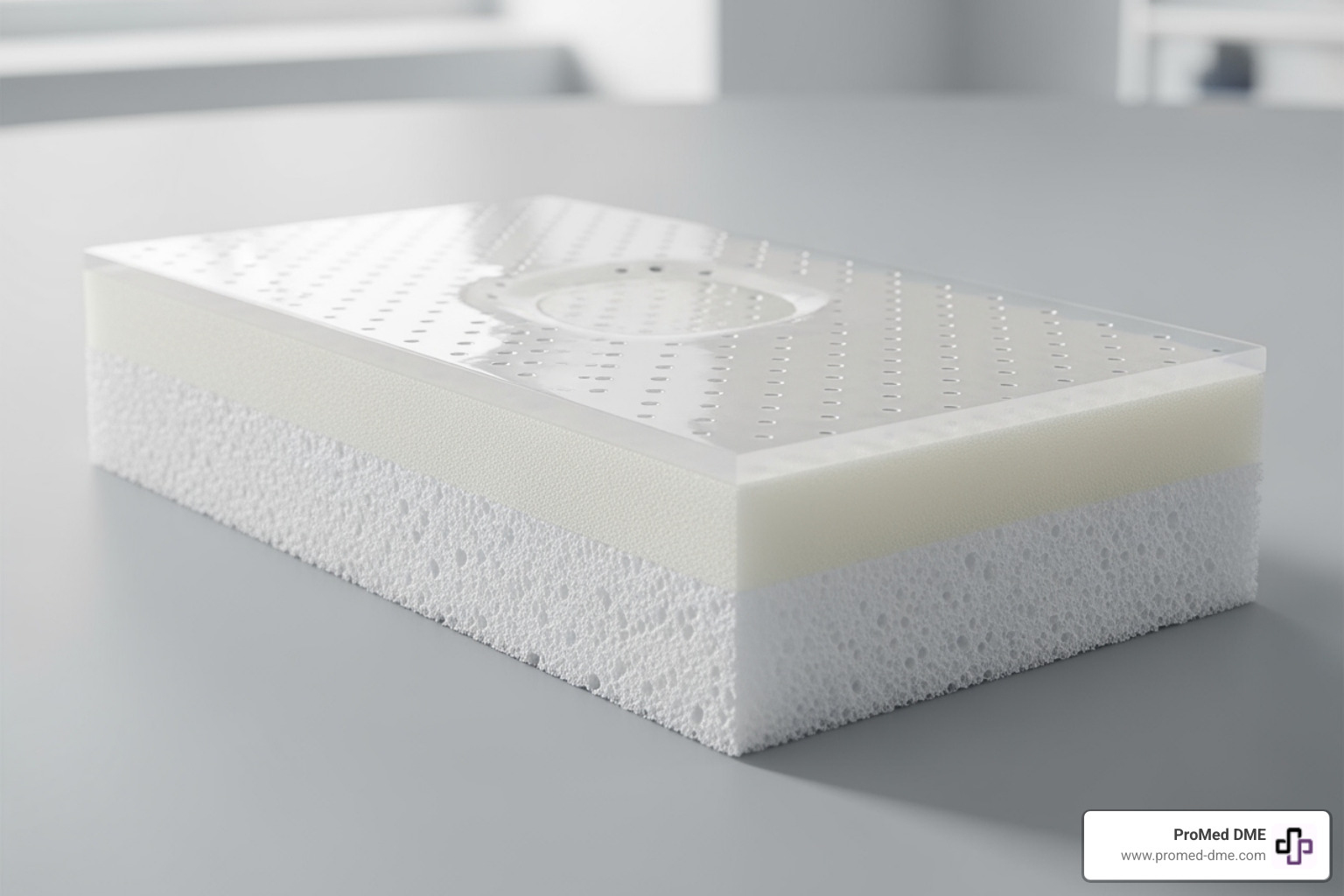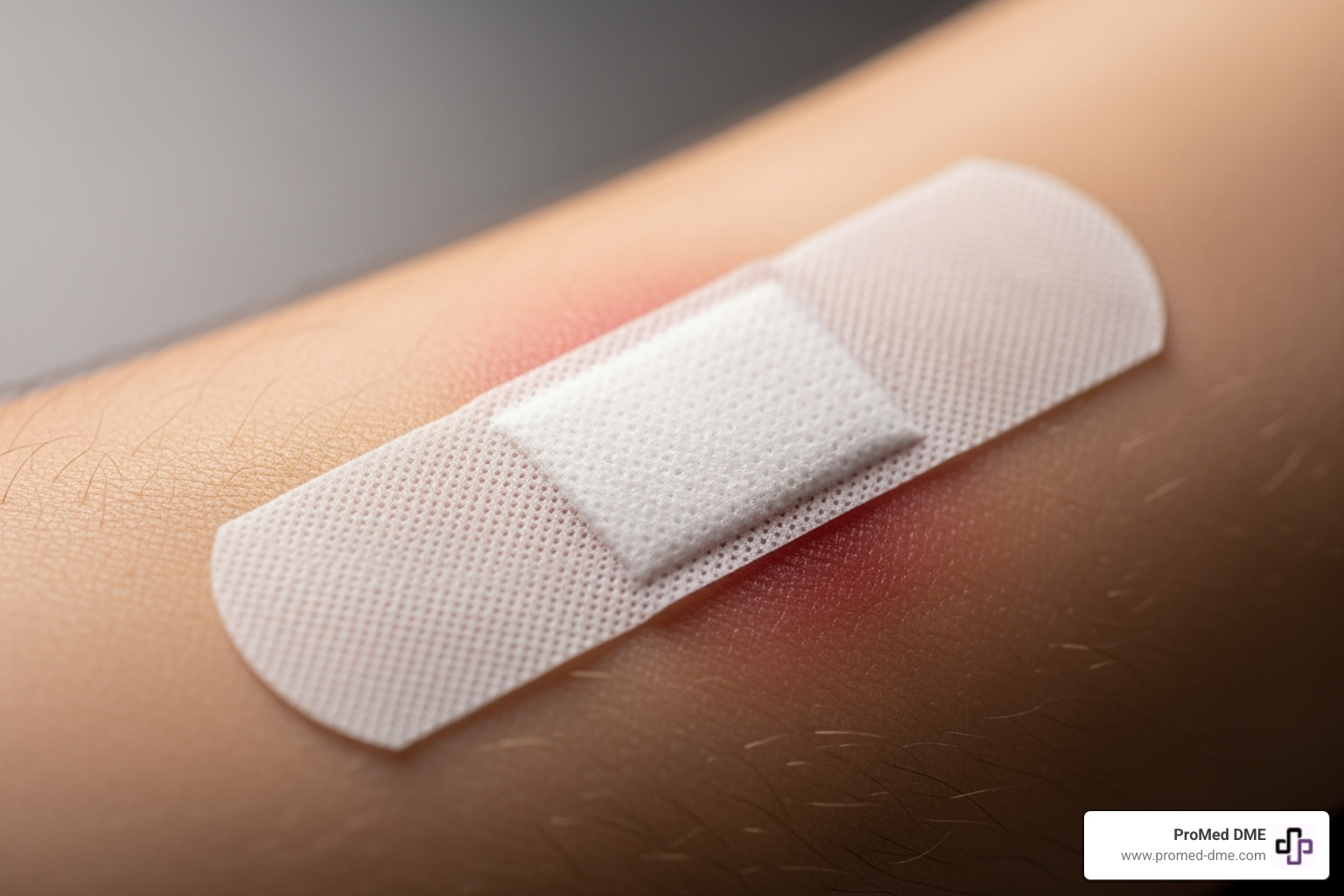Beyond the Basics: A Guide to Cohesive Bandage Wraps
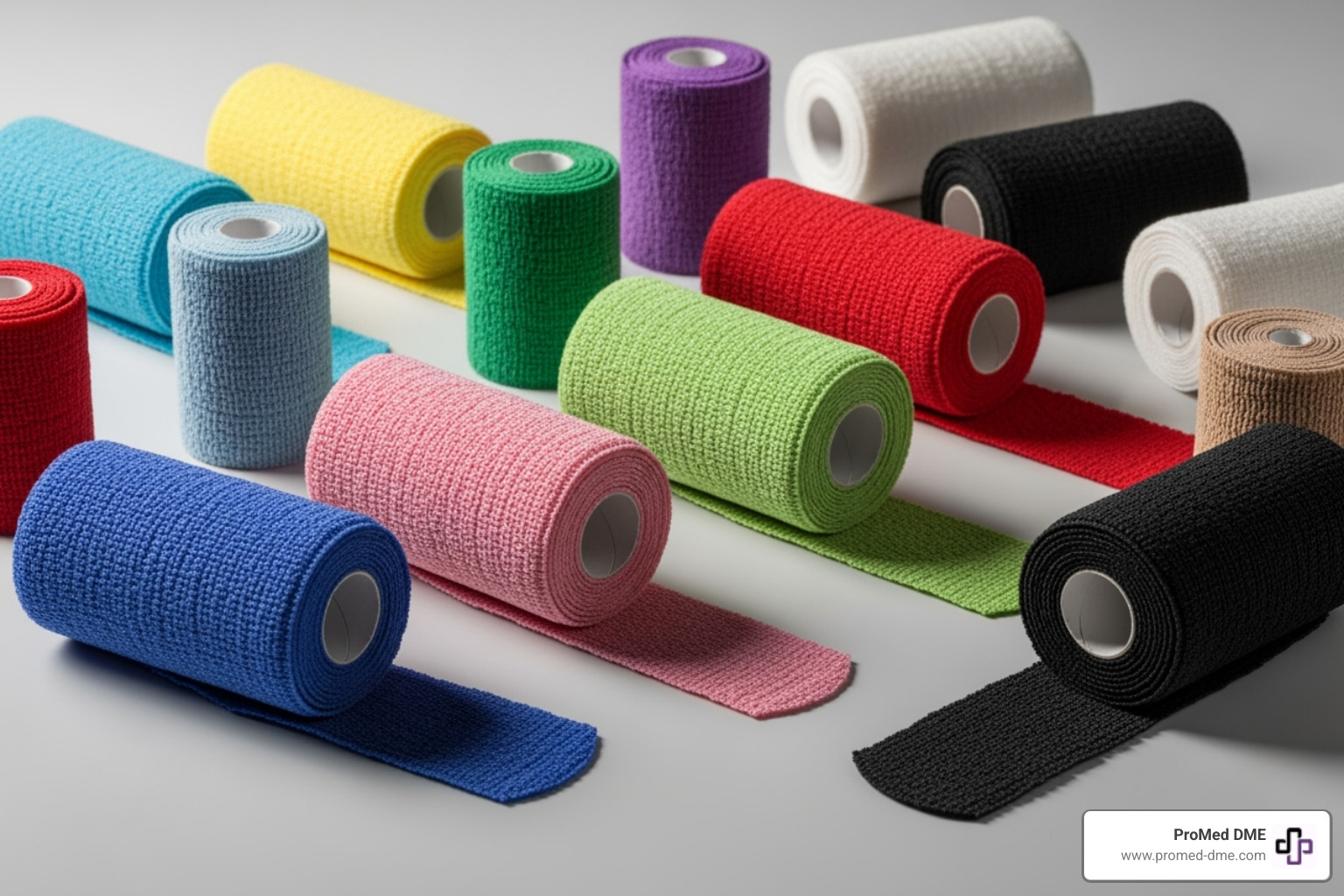
Why Cohesive Bandage Wraps Are Essential for Modern Wound Care
Cohesive bandage wraps are self-adherent elastic bandages that stick to themselves but not to skin or hair. They are a versatile tool for compression, support, and securing dressings, eliminating the need for pins, clips, or tape while providing comfortable support.
Key Features of Cohesive Bandage Wraps:
- Self-adherent - Sticks only to itself, not skin or hair
- Breathable - Allows air circulation to promote healing
- Flexible - Conforms to body contours for custom fit
- Reusable - Can be removed and reapplied without losing adhesion
- No residue - Leaves no sticky residue when removed
- Easy application - Tears by hand, no scissors needed
These wraps are used in various healthcare settings to secure dressings, stabilize sprains, hold ice packs, and support injuries. Veterinarians also use them on animals as they don't stick to fur or feathers.
The breathable material maintains compression while allowing air circulation, which prevents moisture buildup and promotes healing. Knowing how to properly use cohesive bandage wraps can improve comfort and outcomes for sports injuries, post-surgical recovery, and chronic conditions.
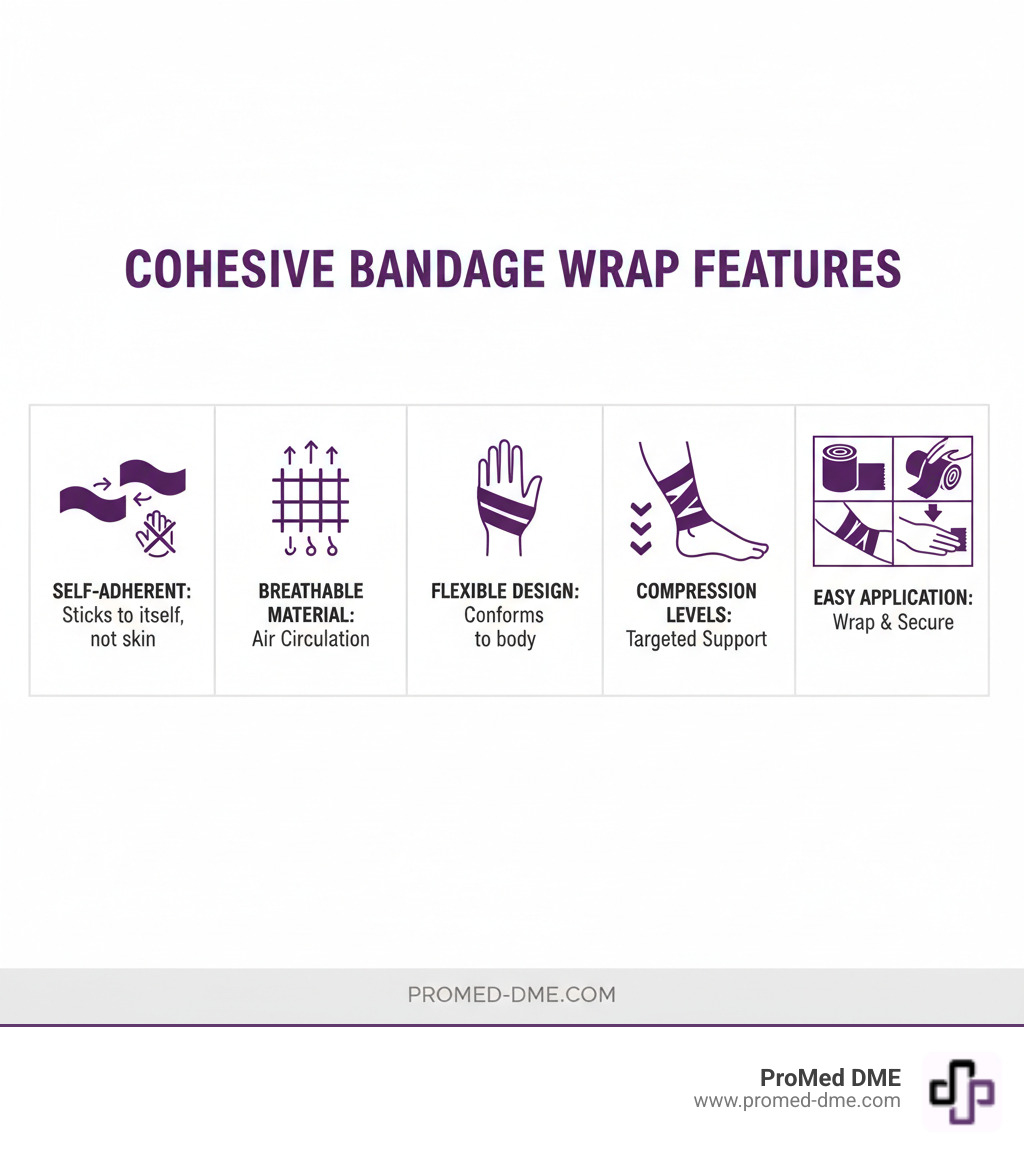
Simple guide to cohesive bandage wraps:
What Are Cohesive Bandages and How Do They Work?
Imagine wrapping a sprained ankle without struggling with clips, tape, or sticky adhesive. With cohesive bandage wraps, you simply wrap, press, and it stays put. These medical supplies work on a simple principle: they stick to themselves, not to you.
This works through cohesion, not adhesion. Unlike adhesive bandages that stick to skin, cohesive bandage wraps have a special coating that bonds only to itself. Overlapping the layers creates a secure bandage that won't slip.
The elastic fibers allow the wrap to stretch and conform to body contours, providing consistent, comfortable compression. This elasticity supports injuries while allowing for natural movement.
Their breathable design also sets them apart. Unlike plastic-backed bandages that trap moisture, cohesive bandage wraps allow air to flow, keeping the area dry and comfortable, which is essential for healing.
| Feature | Cohesive Bandage Wraps | Adhesive Bandages | Elastic Bandages |
|---|---|---|---|
| Adhesion | Sticks to itself only (cohesion) | Sticks to skin (adhesion) | Requires clips/tape to secure |
| Reusability | Often reusable (can be removed and reapplied) | Single-use (adhesive wears off) | Reusable (washable) |
| Compression | Consistent, controlled compression | Minimal compression, primarily for covering wounds | Variable compression, often requires adjustment |
| Skin/Hair | Does not stick to skin or hair, no residue | Sticks to skin, can pull hair, leaves residue | Does not stick to skin/hair, no residue |
| Application | Easy, tears by hand, no clips | Peel and stick | Requires clips or tape, can slip |
| Primary Uses | Support, compression, securing dressings, animal use | Minor cuts, scrapes | Support, compression, securing splints |
The Unique Properties of Cohesive Bandage Wraps
What makes cohesive bandage wraps so special is their combination of user-friendly features.
Sticks to itself, not skin or hair - This prevents pain on removal and leaves no sticky residue, making it ideal for sensitive skin and frequent changes.
No pins or clips needed - Allows for quick, confident application. The wrap stays secure once pressed down.
Consistent compression - The elastic fibers distribute pressure evenly, helping to reduce swelling and provide stability without tight spots.
Lightweight feel - Comfortable for extended wear, many users forget they are wearing it.
Water-resistant - Maintains its integrity when splashed, though it is not fully waterproof.
Common Materials Used in Construction
The unique properties of cohesive bandage wraps come from their materials. The foundation is a soft, strong, breathable, and flexible nonwoven fabric.
Elastic fibers like spandex are woven in to give the wrap its stretch, allowing it to expand and contract with movement while maintaining support.
The cohesive coating, made from natural rubber latex or synthetic polymers, is what allows the wrap to stick only to itself.
For those with latex sensitivities, latex-free options made with synthetic polymers are available. Always check product details if you have a known latex allergy.
Primary Uses: From the Clinic to the Playing Field
Cohesive bandage wraps are a versatile medical supply found in clinics, sports facilities, and veterinary offices. Their ability to stick to themselves but not skin or hair makes them ideal for many situations where traditional bandages fail.
These wraps handle real-world challenges, from providing gentle post-surgical support to securing a wrap on an athlete or a pet. Cohesive bandage wraps deliver reliable performance.
Medical and First-Aid Applications
In healthcare, cohesive bandage wraps are used daily for a variety of applications:
- Securing dressings over wounds is a primary use. They hold dressings firmly without the skin irritation or removal discomfort associated with tape.
- Providing compression for swelling is another key use. The wrap's elastic nature provides consistent pressure to reduce swelling and bruising after injury or surgery, without creating tight spots.
- For supporting sprains and strains, they offer stability by limiting harmful movement while allowing flexibility for daily activities. This balance is crucial for healing without complete immobilization.
- Clinicians use them for holding IV lines in place and securing medical equipment. They stay put without leaving sticky residue, increasing patient comfort during extended use.
- Post-operative support is another key use. They provide gentle pressure to manage swelling and keep surgical dressings secure.
Sports and Athletic Taping
Athletes widely use cohesive bandage wraps for their reliability during competition.
- Joint stabilization is a common athletic use, such as wrapping an ankle or wrist. They provide security without loosening during intense activity.
- Soccer players use them for securing shin pads or socks, as they hold equipment firmly without the discomfort of tape.
- Some athletes use them for enhancing grip on equipment like hockey sticks or tennis rackets.
- Finger and wrist taping for support is popular among athletes like goalkeepers, providing stability without losing flexibility and helping to prevent hyperextension.
Can Cohesive Bandage Wraps Be Used on Animals?
Cohesive bandage wraps are also excellent for animal care, as they don't stick to fur.
- Using them for bandaging limbs without sticking to fur is a major benefit for pet care. They secure dressings on dogs or cats without causing discomfort on removal, reducing anxiety and mess.
- For horses, they are the go-to method for hoof wrapping to secure dressings or support injuries, as they stay in place during movement.
- Every pet first aid kit should include these wraps for addressing minor wounds, securing splints, or protecting incisions.
Veterinarians love these wraps because they make their job easier and keep their four-legged patients more comfortable.
How to Apply Cohesive Bandage Wraps Correctly
Proper application is key to getting the most from your cohesive bandage wraps. The right technique ensures comfortable, effective support and prevents potential harm.
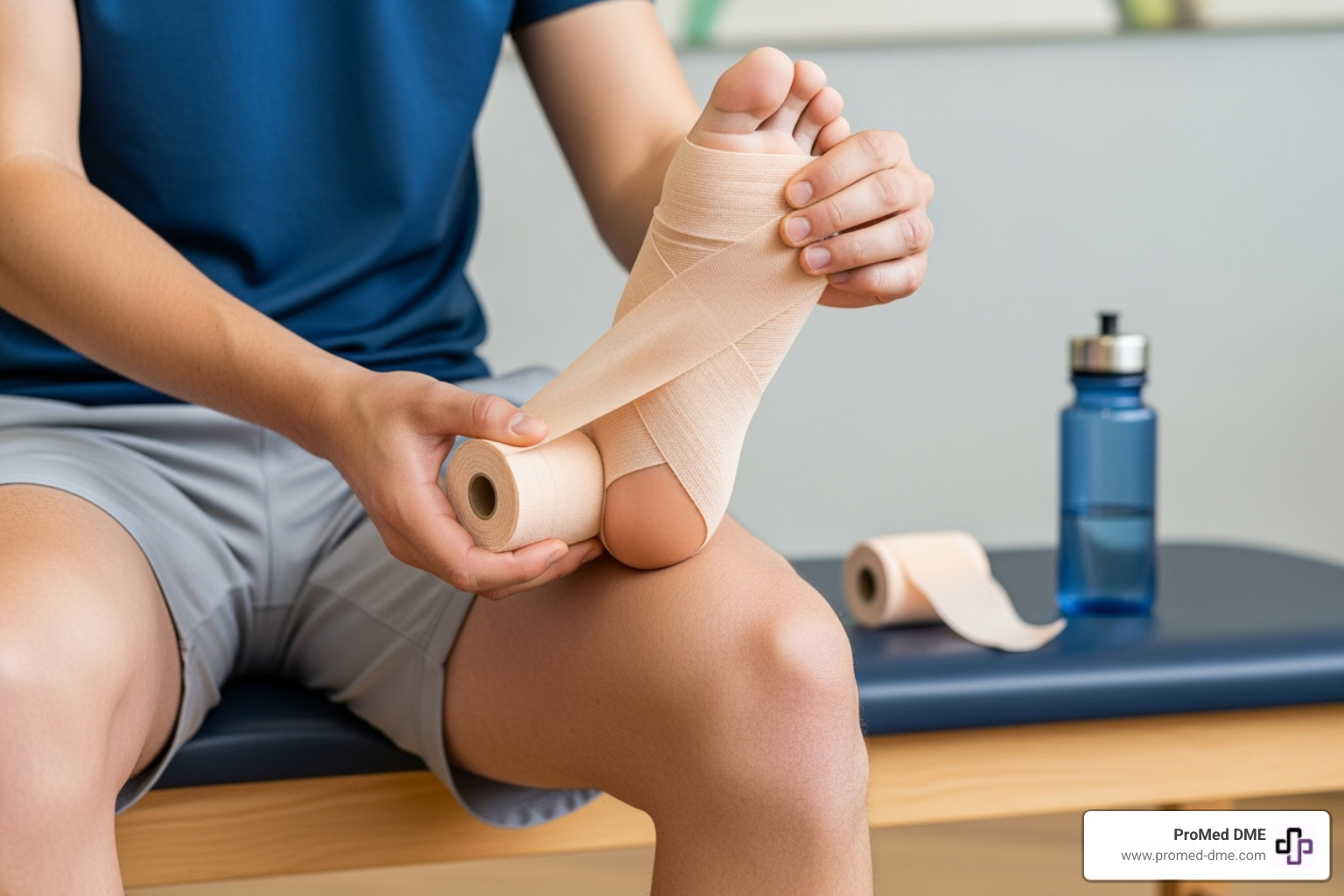
Because they are self-adherent, you don't need to pull them as tight as traditional bandages. Aim for consistent, moderate tension that provides support without cutting off circulation.
Step-by-Step Guide for Common Injuries
Here are guides for some common uses:
Wrist sprains: Start with two wraps around the wrist with gentle pressure. Then, create a figure-of-eight pattern by wrapping diagonally across the back of the hand, around the base of the thumb, and back across the palm to the wrist. Repeat this pattern a few times, then finish by wrapping the wrist once more and pressing the end to secure it.
Ankle support: Hold your foot at a 90-degree angle. Start with two turns around the ball of your foot. Then, create a figure-of-eight pattern, alternating wraps around the foot and the lower shin above the ankle. Overlap each layer by about half. Finish by wrapping up the lower leg and securing the end. This provides stability while allowing movement.
Securing ice packs: Simply place the pack on the injury and use the wrap to hold it in place. The self-adherent wrap provides hands-free cold therapy.
Finger splinting: For temporary splinting, the wrap can be used to secure a small rigid support alongside an injured finger, creating an adjustable custom splint.
Best Practices for Using Cohesive Bandage Wraps
Wrap from the extremity toward your body (distal to proximal), such as from fingers to wrist. This encourages proper blood flow and helps prevent swelling.
Proper tension is critical. The wrap should be snug but not a tourniquet. You should be able to slip a finger underneath the edge; if not, it's too tight and must be loosened.
Check your circulation regularly, especially in the first few hours. Look for numbness, tingling, coldness, or color changes, which are signs the wrap is too tight.
Never place cohesive bandage wraps directly on open wounds. Always apply a sterile dressing first, then use the wrap to secure it.
Maintain even tension and overlap each layer by about half. Quality wraps tear easily by hand, so no scissors are needed.
To finish, press the end of the bandage firmly onto the previous layer to create a secure hold without clips or tape.
Safety Precautions and Proper Care
Cohesive bandage wraps are generally safe, but proper use is essential to avoid problems. Following safety precautions ensures you get the full benefits while staying comfortable.
Potential Risks and How to Avoid Them
The biggest risk is wrapping too tightly, which can cut off blood flow and lead to serious complications.
Watch for warning signs of a wrap being too tight: numbness, tingling, swelling below the wrap, skin color changes (pale or bluish), the area feeling cold to the touch, or increased pain. If these symptoms appear, loosen or remove the wrap immediately. If they don't improve quickly, contact your healthcare provider.
Latex allergies are another risk, as some wraps contain natural rubber latex. Check the label for "latex-free" options if you have a known sensitivity.
Prolonged use can sometimes cause skin irritation, especially in hot conditions. Keep the area clean and dry and monitor your skin.
For serious injuries, deep wounds, or signs of infection, seek professional medical care. These wraps are a tool for support, not a replacement for medical treatment.
Storing and Disposing of Your Wraps
Proper care ensures your wraps are ready when you need them.
- Keep unused rolls in their original packaging to protect them from dust, dirt, and light.
- Store wraps in a cool, dry place at room temperature. Avoid extreme heat or humidity, which can damage the wrap's properties.
- Check expiration dates, as expired wraps may lose their stretch and cohesiveness.
- Used wraps can typically be disposed of in household trash. For heavily contaminated wraps, check local guidelines for medical waste disposal.
- For hygiene, wraps should be single-use only. Reusing a bandage can spread bacteria and risk infection.
Frequently Asked Questions about Cohesive Bandage Wraps
Here are answers to some frequently asked questions about cohesive bandage wraps.
How long can you leave a cohesive bandage on?
The duration depends on its use. For general support or compression, a wrap can typically be worn for up to 24 hours. It's good practice to remove it at night to let the skin breathe and reapply a fresh wrap in the morning if needed.
When securing dressings, replace the cohesive bandage wrap whenever you change the dressing, following your doctor's schedule. Also, change it if the dressing becomes wet or dirty.
Monitoring is key. Check the wrapped area at least daily for redness, swelling, numbness, or tingling. Remove the wrap if you feel any discomfort.
Can cohesive bandages get wet?
Most cohesive bandage wraps are water-resistant, meaning they can handle minor splashes or light rain without failing. However, they are not fully waterproof and should not be submerged.
For showering, protect the wrap with a waterproof cover. If a wrap gets soaked, replace it. A wet bandage can harbor bacteria and cause skin irritation.
If the wrap gets slightly damp, pat it dry. If it feels soggy or loses its grip, replace it.
What are some common types of cohesive bandage wraps?
Several types of cohesive bandage wraps are available for different needs.
Standard cohesive bandages are the most common type, made with nonwoven material, elastic fibers, and often a latex-based coating. They come in many colors.
For those with latex allergies, latex-free options are essential. They use synthetic materials and are clearly labeled for safety.
The width is also important. Use 1-inch wraps for fingers and toes; 2-inch for wrists and hands; 3-inch for ankles and elbows; and 4-inch or 6-inch wraps for larger areas like knees and thighs.
We're proud to offer reliable options at ProMed DME, ensuring you always have access to quality cohesive bandage wraps when you need them most. Whether you're stocking a family first-aid kit, managing a chronic condition, or helping a furry friend recover from a vet visit, having the right type and size on hand makes all the difference in your care experience.
Conclusion
Cohesive bandage wraps have revolutionized wound care and injury support. They are an innovative, practical, and comfortable tool that makes healing easier.
The versatility of cohesive bandage wraps is their key feature. They are used by healthcare professionals, athletes, and pet owners. Their self-adherent, breathable, and flexible nature makes them superior to traditional bandages in many applications.
Proper application is crucial for safe and effective care. Remember to wrap from the extremities toward the heart, maintain snug but not tight compression, and monitor circulation to ensure comfort and promote healing.
These wraps are also a game-changer in veterinary care, providing gentle, effective support for animals without pulling fur or leaving residue.
At ProMed DME, we are your partners in health. Our selected range of wound care products, including high-quality cohesive bandage wraps, reflects our dedication to providing tools that make a difference in your recovery.
Having the right supplies and knowledge can transform your experience. With our free shipping, dedicated nursing support, and help with insurance, we're here to remove barriers to the care you deserve.
Explore our comprehensive wound care solutions and find how ProMed DME can support your journey toward better health and healing. Because when it comes to your well-being, you deserve nothing less than exceptional care and quality products that work as hard as you do.
Related Resources & Articles
Stay informed with our informative blog posts.
Discover the ProMed Advantage
& Try Our Products
We offer free shipping and legendary customer service to ensure you receive the
best DME products for your needs.

